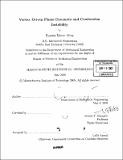Vortex driven flame dynamics and combustion instability
Author(s)
Altay, Hurrem Murat
DownloadFull printable version (7.725Mb)
Other Contributors
Massachusetts Institute of Technology. Dept. of Mechanical Engineering.
Advisor
Ahmed F. Ghoniem.
Terms of use
Metadata
Show full item recordAbstract
Combustion instability in premixed combustors mostly arises due to the coupling between heat release rate dynamics and system acoustics. It is crucial to understand the instability mechanisms to design reliable, high efficiency, low emission gas turbine combustors. In this thesis, elementary processes acting as a source of unsteady heat release rate are described. These elementary processes are acoustic wave-flame interactions, flame-vortex interactions, equivalence ratio fluctuations, flame-wall interactions and the unsteady stretch rate. To investigate the flame- vortex interaction mechanism, a parametric study is performed in single and double expansion dump combustors. 2-D simulations are performed using the random vortex method combined with thin flame model of premixed combustion. The inlet velocity of the combustor is forced sinusoidally at various amplitudes and frequencies, and the heat release rate response is evaluated. It is shown that the heat release rate dynamics are governed by the cyclical formation of a large wake vortex and its interaction with the flame. Maximum heat release rate in a cycle is reached a short time after the breakup of the vortex, which causes rapid burning of the reactants trapped within the structure. The geometry and operating conditions of the combustor control the mechanism by which the vortex breakup is initiated. For short cavities, the impingement of the large wake vortex onto the forward facing step is responsible from the vortex breakup. (cont.) On the other hand, in long cavities, the vortex breakup is initiated as the wake vortex impinges on the upper cavity wall in single expansion dump combustor, or the vortex forming in the other half of the combustor in double expansion dump combustor. Furthermore, the effect of the air injection in the cross stream direction close to the dump plane on equivalence ratio is investigated. It is shown experimentally that high amplitude pressure oscillation in the combustor during unstable operation causes fluctuation in the injected jet velocity. The oscillatory jet velocity affects the incoming equivalence ratio depending on the momentum ratio of the jet to the primary stream. A critical momentum ratio is defined at which the amplitude of the equivalence ratio oscillations reaches a maximum.
Description
Thesis (S.M.)--Massachusetts Institute of Technology, Dept. of Mechanical Engineering, 2005. Includes bibliographical references (leaves 87-93).
Date issued
2005Department
Massachusetts Institute of Technology. Department of Mechanical EngineeringPublisher
Massachusetts Institute of Technology
Keywords
Mechanical Engineering.